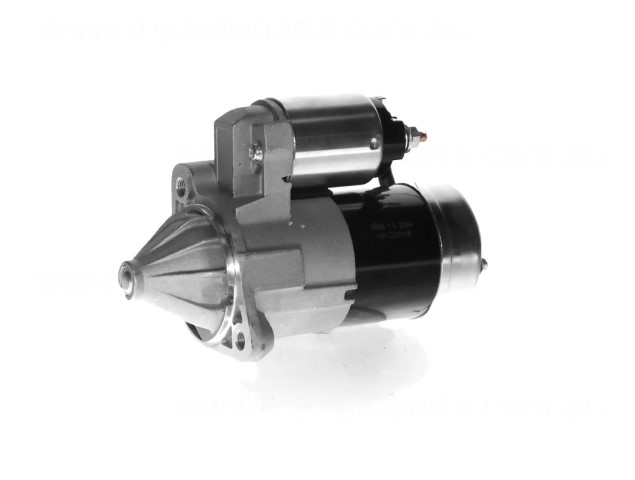 Need a new starter motor? Many of us now have a basic understanding of what a starter motor does in our cars – it’s all in the name. So, we know it has something to do with starting the car, but what does the starter motor actually do? How does it work, and why do we need it in our cars?
Need a new starter motor? Many of us now have a basic understanding of what a starter motor does in our cars – it’s all in the name. So, we know it has something to do with starting the car, but what does the starter motor actually do? How does it work, and why do we need it in our cars?
Knowing a little about how your car works is always helpful. This knowledge can make you aware of any issues that arise before they get worse. In this article, we’ll give you the basics of how the starter works so you can identify any issues with it if or when they arise.
What is a car starter motor?
The starter motor is key to getting your car started. It’s a small electric motor that attaches to the main engine. When you turn your key, the starter motor causes the flywheel to turn, which then leads to the engine starting. Once running, the starter turns off, allowing the combustion engine to run itself.
How a car starter motor works
Looking for more detail on how a car starter motor works? Here’s how. When you turn the ignition key, it sends a small current to the solenoid coil, which consists of the pulling and holding coils. This creates a magnetic field, pulling the piston back and connecting the contactor plate to the main terminals. The pulling coil turns off, while the holding coil keeps the piston in place. This motion engages the pinion gear with the flywheel, starting the engine.
Once the engine runs faster than the starter motor, the clutch unlocks, allowing the pinion gear to spin freely. Releasing the key cuts power to the solenoid, and a spring retracts the pinion gear. The engine continues running, and the alternator recharges the battery.
Components of a starter motor
The starter motor is a pretty intricate piece of technology that is central to how many combustion engines start. Here are the key components of a starter :
Armature
Mounted on the bearings and drive shaft, the armature is an electromagnet that’s designed to offer support. It’s a soft laminated iron core that’s enclosed in several conductor loops.
Commutator
The commutator sits in the shaft near the rear and conducts electricity by the brushes running against it. It’s made with two plates that attach at the axle of the armature, providing connections for the coil.
Brushes
These run against the commuter. As they brush against the commutator, they generate electricity.
Solenoid
The solenoid has two coils of wire wrapped around a movable core. It acts as a switch, connecting the starterto the car’s battery.
Plunger
The plunger, powered by the battery and solenoid, moves forward to engage the pinion.
Lever Fork
The lever fork is attached to the plunger. When the plunger moves forward, it pushes the lever fork, which then activates the pinion.
Pinion
The pinion is a gear with springs. When the starter motor is activated, the pinion moves into the gearbox and engages with the flywheel, spinning the engine to start it.
Field Coils
The starter motor has field coils held in place by screws. There are usually two to four field coils connected in series. When powered by the battery, these coils become electromagnets that turn the armature, creating a magnetic field around it.
While this description of the components in a starter might seem long and complicated, remember that this all happens when you turn your key. This all happens over a few seconds.
How do you spot issues with your starter motor?
Now that you’re all caught up on how the starter motor works, let’s go through a few ways to identify when it’s not functioning as it should:
- The first and most noticeable indicator that something is wrong with your car will usually be the warning lights on your dash. Check if the warning light comes on there first
- Another common sign that your starter motor is dead is a consistent “clicking” sound that’s often followed by your car not starting. Even if you don’t hear the clicking sound, there’s a chance that the starter is still the issue
- You might also hear the starter cracking slowly. This means that the crack is struggling to turn, indicating an issue with the starter possibly
- Starter motors are primarily composed of electric components, making them prone to electrical issues. If you try to start your car and notice smoke, this could indicate an electrical problem in the starter. It is essential to address this promptly. A motor drive analyzer can be used to quickly and accurately diagnose and pinpoint the exact problem
- In rare cases, a leak in the oil system could cause oil to leak onto the starter motor. As a result, this could cause the starter to malfunction in a few different ways. To check for this, simply pop the hood of your car and look for the starter motor. If it’s clean, then you’re in the clear
Final Thoughts
We’re all capable of getting a little bit of grease under our nails from time to time. Being able to identify issues with your car could save you a lot of time and money on repairs. So keep learning, know your car inside and out. Who knows, by the end of it you may be the one replacing broken parts.










